Abstract
Urban forms are closely related to the urban environment, providing great potential to analyze human socioeconomic activities. However, limited studies have investigated the impacts of three-dimensional (3-D) urban forms on socioeconomic activities across cities. In this paper, we explored the relationship between urban form and socioeconomic activities using 3-D building height data from 38 cities in China. First, we aggregated the building footprint data and calculated three building indicators at the grid scale, based on which the spatial patterns of building height and road density were analyzed. Then, we examined the capacities of two-dimensional (2D)/3D urban forms in characterizing socioeconomic activities using satellite-derived nighttime light (NTL) data. Finally, we analyzed the relationship between road density distributions and building heights across 38 cities in China. Our results suggest that the building height information can improve the correlation between urban form and NTL. Different patterns of road distribution were revealed according to the distribution of road density change from the building hotspots, showing the capacity of 3-D building height data in helping characterize socioeconomic activities. Our study indicates that the 3-D building height information is of great potential to support a variety of studies in urban domains, such as population distribution and carbon emissions, with significantly improved capacities.
1. Introduction
The world has been undergoing rapid urbanization over the past decades with a great number of people migrating into urban areas, which brought urban environmental issues and challenges for urban sustainable development [1,2,3,4]. Currently, over 55% of the population resides in urban settlements globally, and this rate is expected to grow to 68% by 2050 [5]. Anthropic socioeconomic activities, the primary activities of cities, are closely related to the changing urban environment and considerably alter the urban environment with intensified urban morphology (i.e., changing urban structures, land cover types, and functions) [6,7]. Urban forms are generally used to characterize the consequences of human activities indirectly. For example, urban forms have significant influences on urban heat island effect, greenhouse gas emissions, energy consumption, urban ecosystem, and even public health [8,9,10]. As such, it is crucial to investigate the relationship between urban form and socioeconomic activities for understanding urban development and human behaviors.
A number of indicators have been proposed to characterize urban forms with diverse applications. For example, Liang et al. provided insights into the relationship between urban form and heat island intensity alongside the urban development gradients for urban optimization [11]. Wang et al. quantified the impacts of urban forms on emission using indicators of the area and landscape shape indices [12]. Urban forms have been used to explain the effects on the urban environment, such as land surface temperature [13] and air pollutants [14,15]. Furthermore, urban forms are insightful to investigate the relationship between human behaviors and socioeconomic activities. Mouratidis et al. confirmed that urban forms could affect social behaviors and relations [16]. Zhou and Gao investigated the impacts of urban form changes on transportation modes [17]. Bruno et al. analyzed the relationship between urban form and energy consumption using the regression model [18]. However, most studies only considered these metrics of the urban environment and human activities from the horizontal aspect (i.e., two-dimensional; 2-D), with limited attempts on the vertical information.
Three-dimensional (3-D) urban forms characterize urban morphology better than 2-D urban forms, providing more detailed information about the spatial structure in the vertical direction. Tian et al. compared the effects of 2D/3D urban morphology on air temperature in residential neighborhoods and found that 3D morphology is more important for temperature prediction [19]. Zhi et al. demonstrated the scale effect of the relationship between 3-D urban forms and urban island heat [20]. Chen et al. analyzed the spatial relation between energy demand and urban morphology indicators, including building height and volume [21]. Song et al. adopted the 2-D urban metrics to investigate the impacts on urban commuting travel [22]. Although most of the studies investigated the impacts of urban form on the urban environment, limited studies explored the effects of 3-D urban forms on socioeconomic activities.
To fill the research gap, this paper explored the relationship between 3-D urban forms and socioeconomic activities using building footprint data with height information. On the one hand, we compared the capability of characterizing the socioeconomic activities (i.e., represented by the nighttime light data) using 2D and 3D urban forms from a macroscopic perspective. On the other hand, we analyzed the relationship between road density patterns and the building height data in a quantitative manner from a microcosmic perspective. The remainder of this paper is organized as follows: Section 2 introduces the dataset used in this study. Section 3 provides the data pre-process and analysis approaches. Section 4 presents the results with analysis, with an ending mark shown in Section 5.
2. Materials
We adopted four types of datasets in our study, including building footprint data, nighttime light data, road network, and impervious surface area data. Although Interferometric synthetic aperture radar (InSAR) and airborne Light Detection and Ranging (LiDAR) provide a good proxy measure for urban building height estimating at the global scale [23,24,25], these data are not inappropriate for urban form calculation and analyses at a large scale with fine resolution due to the cost and labor. Instead, we collected the building footprint data with height information in 38 cities in China to characterize the urban form. The building height data were collected from https://www.amap.com/ (accessed on 6 January 2022) (Figure 1), including 33 prefecture-level cities, four municipalities, and one special administrative region. The building footprint data are polygons with height information, represented by the floor number of each building. Buildings are mainly distributed in the built-up area, and their extents generally are smaller than the administrative boundaries of cities. In addition, we also used the Global Artificial Impervious Area (GAIA) data as a reference for comparison with urban form indicators of buildings [26].
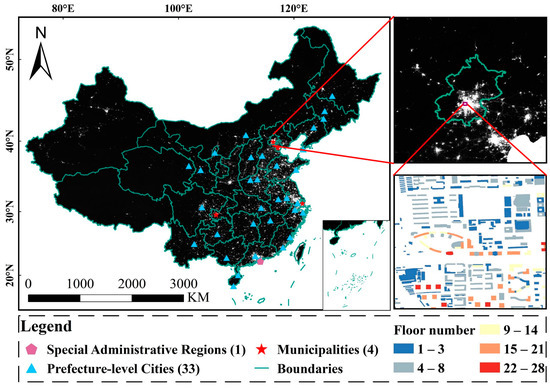
Figure 1.
Spatial distribution of 38 cities in China. The base map is the nighttime light data derived from the Luojia-1 satellite in 2018. Figures on the right panel show the building footprint data with height information in Beijing.
We used the nighttime light (NTL) data as a proxy to represent the socioeconomic activities due to its high correlation with the energy consumption and gross domestic product (GDP), although the definition of socioeconomic activities is wide with associated travel behaviors and living styles that are difficult to be detected by the NTL data [27,28,29]. The Luojia-1 satellite was launched in 2018, and it records the intensity of nighttime light with a spatial resolution of 130 m, and the local time of Luojia-1 is approximately 9:30 p.m., thus the city lights can be well detected by satellites. As a valuable tool to reflect the socioeconomic activities from the space, the Luojia-1-derived NTL data have been widely used in various applications such as urban economic activity measuring [30], urban area mapping [31], and light pollution evaluation [32]. With a higher spatial resolution, Luojia-1 is more capable of detecting built-up areas than other NTL satellites, such as Visible Infrared Imaging Radiometer Suite (VIIRS) [33]. Therefore, we used the NTL data from Luojia-1 to represent the intensity of China’s socioeconomic activities (e.g., electricity consumption) and evaluated the impact of building height information on the intensity of these activities.
We also collected the urban road data from Open Street Map (OSM) to evaluate the efficiency of road density and spatial patterns in cities. The OSM data is publicly available and can be freely downloaded from https://www.openstreetmap.org/ (accessed on 6 January 2022). In total, there are 27 road types in the raw dataset, based on which we extracted eight main road types in the urban areas, as shown in Table S1. These road categories and types were not used separately in the following analysis because of the complex processing, and we instead generally regarded them as a complete road network.
3. Methodologies
We developed the framework below (Figure 2b) to evaluate the impact of vertical urban forms on socioeconomic activities from a macroscopic perspective, on the one hand. On the other hand, we explored the application of building height data in the specific urban study (Figure 2c) from a microscopic perspective. First, we generated seamless fishnets covering the entire spatial extent of cities at different resolutions, based on which three urban building indicators were calculated (Figure 2a). We characterized the distribution of buildings and roads using the kernel density approach. Then, we compared the correlation between 2D/3D building forms and the NTL data using the linear regression approach. Finally, we explored the relationship between the road distribution pattern and urban form by analyzing the locations of urban cores. Details about the methods are provided in the following sections.
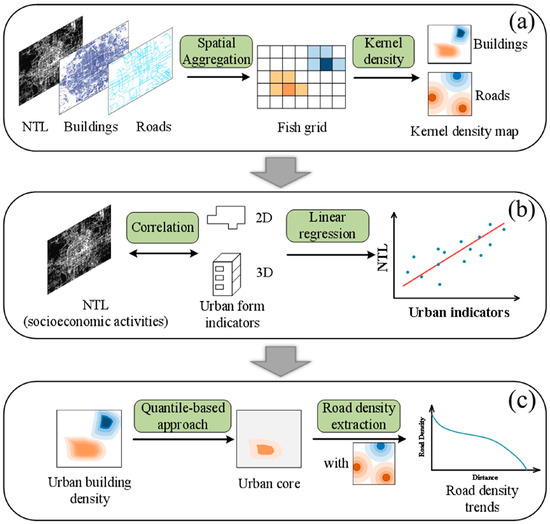
Figure 2.
The proposed workflow in this study. (a) data preprocess; (b) correlation analysis between 2D/3D urban forms and nighttime light; (c) the relationship between building height and road density.
3.1. Data Preprocess
There are typical 2D/3D building urban forms, e.g., building area, building volume, sky view fraction, and frontal area index for different applications [20,34,35,36]. We calculated three building indicators, i.e., building area, impervious surface area (ISA), and building volume. These indicators were calculated at six resolutions (i.e., 500 m, 1 km, 2 km, 3 km, 4 km, and 5 km). The building area refers to the area of all building blocks in a unit cell, and building volume is defined as the building area multiplying the mean floor number in a unit cell (i.e., here we assumed the height of each floor is 3 m). At the same time, the ISA was derived from the global artificial impervious area (GAIA) data at 30 m resolution [26], serving as a representative indicator for the urban area. Besides, the NTL data were also aggregated to the same resolution as these building indicators for analyses. NTL data was aggregated to the fish grid using the zonal statistics method, and the nearest resampling approach was adopted to match the spatial resolution before the zonal operation was performed.
We retrieved the building and road densities profile using the kernel density approach. Firstly, we calculated two indicators, i.e., the average floor number and the total road length in each cell at the fish grid. The average floor number was used to characterize the distribution of the urban core regions, and the road length was used to evaluate the accessibility of the road network. Secondly, we implemented the kernel density analysis based on the two derived gridded indicators. Thus, the spatial distribution of building height and roads from the urban core to rural areas can be well characterized.
3.2. The Correlation between Urban Form and NTL
Using the linear regression model, we explored the relationship between urban form and the NTL data to represent socioeconomic development. We used all building footprint data of 38 cities in China in our analysis at six resolutions. We chose indicators of building area, ISA, and building volume as three representatives of urban form. It is worth noting that the building area and volume were directly calculated from the building footprint data. Besides, given that the radiance in NTL has a wide range of magnitude, we implemented a logarithmic transform before the regression. The optimal scale for analysis was determined by analyzing the sensitivity of different spatial resolutions.
3.3. The Relationship between Road Density and Building Height
We identified different road distribution patterns by analyzing the road density change around the urban core areas within each city (Figure 3). Firstly, we extracted urban cores (i.e., regions with high building densities and heights) using a quantile-based approach. Then, we measured the road density changes from urban cores to surrounding areas.
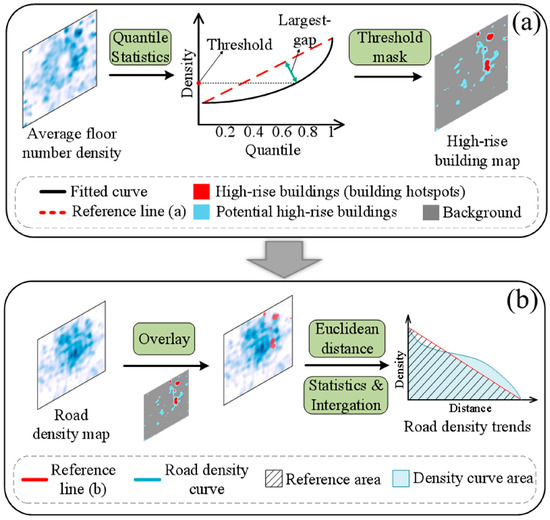
Figure 3.
Illustration of the road distribution analysis. (a) Identify the high-rise buildings (building hotspots) using the quantile-based approach. (b) Analyze the road density pattern change from the city core to rural areas.
3.3.1. Quantile-Based Approach to Building Masking
We used a quantile-based approach to identify those urban cores dominated by dense high-rise buildings (i.e., building hotspots). First, we derived the kernel density map of the average floor number, which can reflect the overall characteristics of building height in each grid. Several typical buildings such as conference centers and terminals, which are low-rise buildings but occupy a large floor area in practice, would be regarded as building hotspots if building volume was used as the variable to extract building hotspots, so we used average building height to represent the overall building height in the unit cell instead of building volume.
Then, we calculated the quantile levels of the average floor kernel density map, as illustrated in Figure 3a. Considering that building hotspots are relatively small in each city, we determined the turning point with the largest gap to the reference line (i.e., dotted red line in Figure 3a) to separate those relatively high- and low-rise buildings. This approach has been successfully applied in other studies such as urban extent mapping [37,38,39]. Finally, those pixels with floor number density above the determined threshold were regarded as the urban core dominated by high-rise regions, which are likely to be the central business districts (CBDs).
We applied the quantile-based approach to extract the high-rise buildings. The areas with light blue color are the potential high-rise buildings, which were initially derived from building kernel density map using the quantile-based approach (Figure 3a). The red color areas in the extracted map are the finally extracted high-rise building clusters, derived from the potential high-rise buildings.
3.3.2. Road Distribution Pattern Extraction
We analyzed the road distribution patterns by measuring the road density change from the urban core (i.e., identified high-rise buildings and hotspots) to surrounding rural areas (Figure 3b). First, we computed the distance of each pixel to the nearest building hotspots pixels using the Euclidean distance analysis. The building hotspots were kept as the source, and the rest non-building hotspots areas were set as No-data pixels. The Euclidean distance map result shows the distance value of each non-hotspot pixel to the nearest building hotspot, and there are plenty of pixels with the same distance value. Thus, we regarded those pixels with similar distances to the building hotspots as concentric rings. Then, we calculated the average value of road density within each concentric circle, with a distance interval of 100 m for a finer detection of road density change. Finally, we quantified the ratio of the area under the curve to the referred one (Figure 3b) to identify different road distribution patterns (details can be found in Section 4).
4. Results and Discussion
4.1. Correlation with NTL Data
The NTL is positively correlated with urban form indicators, and the correlation coefficients increase when the grid scale becomes coarser (Figure 4). The regression results for different scales are provided in the Supplementary Materials (Figure S1). There are many uncertainties when the grid scale is small, and these uncertainties are eliminated by averaging as the scale increases, resulting in a relatively high correlation. However, it is worth noting that those coarse girds may ignore many spatial details. Considering the data analysis requirement for road distribution patterns, we chose the grid with a scale of 1 km in this study.
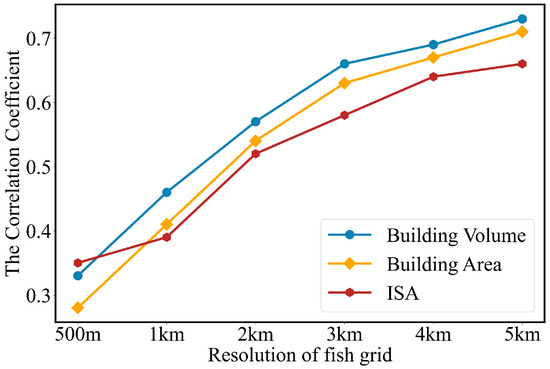
Figure 4.
Pearson correlation coefficients between three indicators (i.e., building volume, building area, and ISA) and NTL data at six resolutions.
Our result shows that building volume has the strongest correlation with nighttime light in most cities, and the points are more concentrated than others (Figure 5). Overall, the correlation coefficient of the building volume is the highest, followed by the correlation coefficients of building area and ISA sequentially. The ISA represents the total area of impervious surfaces that contain non-building objects (e.g., roads, parking lots), which has a low correlation coefficient with NTL data. Therefore, the indicator of building area is better than ISA in characterizing the socioeconomic activities, although both of them belong to 2-D indicators. Likewise, building volume has the best agreement with NTL among these three indicators and its RMSE value is also the lowest. In general, building hotspots (e.g., residential and commercial) are associated with more electrical consumption with intensive socioeconomic activities than those low-rise buildings. Hence, 3-D urban morphology indicators, such as building volume, are more suitable to characterize socioeconomic activities accurately than other indicators.

Figure 5.
The linear regression between urban form indicators and the NTL data at the grid scale (5 km) from 38 cities in China. (a), building volume; (b), building area; (c), ISA.
4.2. The Extracted Urban Cores
The quantile-based approach can well characterize the urban core region (e.g., dominated by high-rise buildings). Visually, the extracted urban core regions (red color in Figure 6c) are consistent with the kernel density-derived maps (i.e., deep blue color in Figure 6b), suggesting that the adopted quantile-based approach can automatically identify the optimal threshold from the density map of average building height. If a 2D indicator, such as the building density, was used in the kernel density analysis, the quantile-based approach would also perform well. However, these identified areas cannot reflect the actual travel behaviors (Figure S2) as compared to the result from building height.
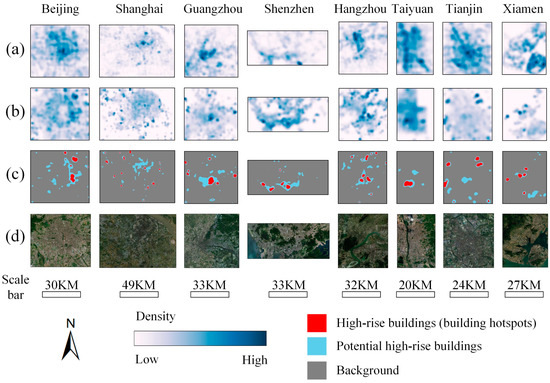
Figure 6.
Kernel density maps and the extracted urban core results in eight representative cities. (a) road density map; (b) average building floor number density map; (c) high-rise building extraction; (d) satellite image map.
We found that the spatial distribution of building hotspots and road hotspots from kernel density maps shows a noticeable spatial variation in different cities. Most building hotspots are located in CBD and residential areas, whereas areas with relatively high road densities are mainly distributed in built-up regions. Although some extracted building hotspots (e.g., high-rise residential areas) are not located in those core regions (e.g., city centers), it is worth noting that those high-rise buildings are likely to be CBDs and residential areas, which are always regarded as the source and destination of commuting with high pedestrian and traffic flow. The relatively high road density around the CBDs can significantly reduce the urban traffic and commutes. In contrast, road distribution with high densities away from building hotspots may suggest inappropriate traffic network planning in cities.
4.3. Identification of Road Distribution Patterns
4.3.1. Classification of Road Distribution Patterns
Different road distribution patterns can be revealed from the curves of road density (Figure S3). The ratio of area under the curve and the reference line was calculated across these 38 cities (Figure 7). The reference line is determined by two points, i.e., the beginning of the road density curve and the maximum distance on the X-axis. We regrouped these cities into three primary groups according to their curves to identify different road distribution patterns. Cities with a ratio value above 1.2 are grouped in the imbalanced type, of which most cities are associated with the density curves significantly above the reference one, suggesting roads are densely distributed around CBD areas. For cities with ratio values between 0.9 and 1.2 (around 1), they are regarded as balanced patterns, and their road density curves are almost parallel with the reference line. The remaining cities are regarded as the sustainable pattern with ratio values below 0.9, i.e., the road density curves are below the reference line in general. The three road distribution patterns are explained in the following sections.
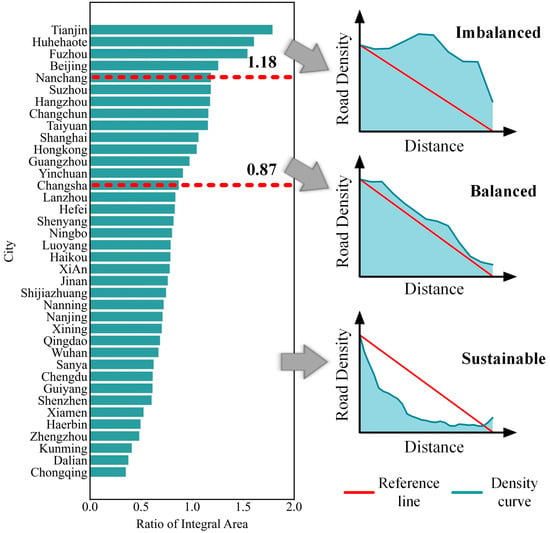
Figure 7.
The integral area of different cities and the three types of road distribution patterns.
4.3.2. Association with City Size
We also divided these 38 cities into three groups (i.e., small, medium, and large), based on the population size, to analyze the road distribution patterns among different city sizes. Most large and medium cities are centered in the northern and coastal regions, while smaller cities are mainly distributed in the west and north of China (Figure 8a). As well, cities with the “Imbalanced” pattern are located in the northern part of China, and cities with the “Balanced” pattern are mostly found in the south and east parts (Figure 8b). The remaining cities are mainly associated with the “Sustainable” pattern, which is the predominant pattern in China overall.
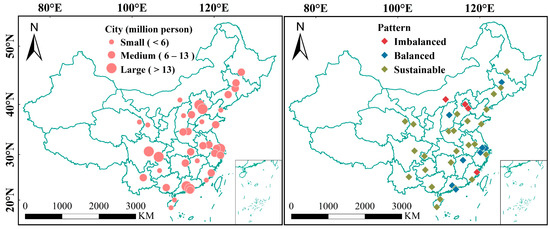
Figure 8.
The spatial distribution of cities with different populations sizes (a) and the road distribution patterns (b).
Furthermore, there is a general trend of the proportions of “Imbalanced”, “Balanced”, and “Sustainable” among cities of different sizes (Figure 9). Overall, the “sustainable” pattern predominates among different city sizes, i.e., the proportions are 42%, 74%, and 67% in city groups with large, medium, and small, respectively. The proportion of the “balanced” pattern is fairly close in all city groups, whereas the “imbalanced” pattern is the lowest.

Figure 9.
Statistics of road distribution patterns in cities of different sizes.
4.3.3. Differences among Road Distribution Patterns
The road density curve is influenced by the relative distance between building hotspots and road hotspots. The first pattern, which is named as “imbalanced” pattern, refers to the imbalanced distribution of building and road hotspots. Cities with imbalanced pattern always have multiple road density hotspots in the built-up areas that are away from the identified CBDs. Taking Tianjin as an example, the city’s building hotspots clusters are dispersed across built-up areas (Figure S4a). The areas associated with high road density are primarily located in the central city, resulting in a considerable distance between the building hotspots and road hotspots, as well as the increased cost of travel. As a result, when the distance reaches the road hotspots, the road density curve will be raised at the long distance from the building hotspots. Likewise, comparable cases exist in Fuzhou and Beijing, where the building hotspots are located far away from the road hotspots.
The second pattern has a similar but closer distance between building hotspots and road hotspots than the imbalanced pattern. This (balanced) pattern refers to the balanced distribution of building and road hotspots, and almost linearly declining curves along the reference line. Taiyuan, a representative city of the balanced pattern, has roads distributed evenly and building hotspots located in the central city (Figure S4b). The balanced distribution of the building and road hotspots results in a linear decline in the road density curve. However, not all of the cities’ curves have ideal linear decline. The road density curve of Hangzhou city has a rapid decrease at the start and two rising fluctuations in the middle that are higher than the reference line. The two rising fluctuations occur later than the rising fluctuation on the imbalanced pattern curves because the relative distance between building and road hotspots decreases. Regarding the curve of Shanghai city, there is a building hotspot located in the central city overlapping with road hotspots, but other building hotspots are scattered with low road density nearby, resulting in the decline of the curve. The extremely high value at the ending of the road density curve is caused by the relatively high road density at the corner of the road density map as the distance increases, therefore, the extreme value is not used as a reference for the balanced pattern.
Compared to the previous two patterns, the distributions of buildings and road hotspots in the third (sustainable) pattern are more concentrated, suggesting that areas around these building hotspots are associated with high road densities. For instance, the curves of the pattern show an exponentially declining tendency because the building hotspots are adjacent to or even within road hotspots (Figure S4c). The exponential curves with high road densities around the city center are helpful to the daily traffic, with a relatively low cost of travel. Urban transportation is one of the most important components of the socioeconomic system and is closely tied to urban sustainability. As a result, this pattern indicates that the cities have sustainable road distribution for urban transportation. Additionally, urban planning in fringe areas with extended accessibility is highly required for urban expansion and sustainable management. Compared with the satellite maps, some unfilled areas are occupied by the non-artificial surfaces (e.g., hills and rivers), which impact the road density curve and cause the fluctuation troughs on the curves. For example, the built-up area in Lanzhou city is long and narrow from west to east, and in the road density map of Nanjing city, there is a conspicuous white curve that is Yangtze River passing the city with unoccupied areas remaining (Figure S5).
5. Conclusions
In this study, we developed a framework to evaluate the impacts of vertical urban forms on socioeconomic activities. On the one hand, we investigated the effects of the 2D/3D urban form indicators (i.e., building volume, building area, and impervious surface area) on NTL using linear regression analysis at a grid scale from the macroscopic perspective. Our results show that the correlation coefficient between building volume and NTL data is slightly better than the other 2D indicator with the improved correlation coefficient and reduced RMSE, suggesting that the 3-D urban forms can better characterize the socioeconomic activities embodied in the vertical dimension. On the other hand, from a microcosmic perspective, we identified the road distribution patterns across 38 cities in China in a quantitative manner. We regrouped these cities into three groups (i.e., small, medium, and large) and identified their patterns of road distribution: imbalanced pattern, balanced pattern, and sustainable pattern, based on the road density curve and density map. The three patterns show spatial variations of the road distribution in/around the city center, which might be helpful to urban planning and road construction.
However, although these three types of road distribution can reflect their physical patterns and the traffic condition, they cannot directly reflect the traffic congestion. For example, the worst congestion in Beijing city generally is distributed at the east and west of the second ring roads, while the highest road density is exactly in the central city [40]. The identification result of urban cores will be improved with detailed information about land/building use type, which is helpful to distinguish different functional regions. In addition, here in this study we only considered ground transportation without rail transportation such as the metro system, which also plays an important role in commuting travel and can be improved in future studies.
Overall, we provided new aspects to evaluate the electricity consumption using 3-D building height information in this study, showing great potential to support other socioeconomic studies and urban planning. With the incorporation of urban data (e.g., the building use type and social information), the 3D building data are more helpful in supporting urban studies such as population distribution and carbon emissions in urban areas.
Supplementary Materials
The following are available online at https://www.mdpi.com/article/10.3390/rs14092087/s1. Table S1: Aggregated roads from Open Street Map. Figure S1: The regression results in different scales. Figure S2: The extracted areas using the quantile-based approach with 3D (a) and 2D (b) indicators in Beijing. Figure S3: The road density curves of all cities. Figure S4: Illustration of the road density curve change in representative cities with different road distribution patterns. Figure S5: Satellite images of six cities.
Author Contributions
Conceptualization, X.L.; methodology, X.L. and G.Y.; software, G.Y. and Z.X.; visualization, G.Y. and Z.X.; resources, X.L.; data curation, G.Y. and Y.W.; investigation, G.Y.; supervision, X.L. and X.Y.; validation, G.Y. and X.L; project administration, X.L. and X.Y.; formal analysis, G.Y. and X.L.; writing—original draft preparation, G.Y.; writing—review and editing, X.L., G.Y., Y.W., Z.X., X.Y. and J.H.; funding acquisition, X.L. All authors have read and agreed to the published version of the manuscript.
Funding
This research was partly funded by the National Natural Science Foundation of China (42101418).
Data Availability Statement
The data presented in this study are available on request from the corresponding author.
Acknowledgments
We acknowledge the Open Street Maps for their share of the road networks.
Conflicts of Interest
The authors declare no conflict of interest.
References
- Cohen, B. Urbanization in developing countries: Current trends, future projections, and key challenges for sustainability. Technol. Soc. 2006, 28, 63–80. [Google Scholar] [CrossRef]
- Chen, J. Rapid urbanization in China: A real challenge to soil protection and food security. Catena 2007, 69, 1–15. [Google Scholar] [CrossRef]
- Arfanuzzaman, M.; Dahiya, B. Sustainable urbanization in Southeast Asia and beyond: Challenges of population growth, land use change, and environmental health. Growth Chang. 2019, 50, 725–744. [Google Scholar] [CrossRef]
- Xiong, Y.; Huang, S.; Chen, F.; Ye, H.; Wang, C.; Zhu, C. The Impacts of Rapid Urbanization on the Thermal Environment: A Remote Sensing Study of Guangzhou, South China. Remote Sens. 2012, 4, 2033–2056. [Google Scholar] [CrossRef] [Green Version]
- United Nations, Department of Economic and Social Affairs. World Urbanization Prospects: The 2018 Revision (ST/ESA/SER.A/420); United Nations, Department of Economic and Social Affairs: New York, NY, USA, 2019; Volume 12, ISBN 9789211483192. [Google Scholar]
- Dadashpoor, H.; Azizi, P.; Moghadasi, M. Land use change, urbanization, and change in landscape pattern in a metropolitan area. Sci. Total Environ. 2019, 655, 707–719. [Google Scholar] [CrossRef] [PubMed]
- Wu, H.; Lin, A.; Xing, X.; Song, D.; Li, Y. Identifying core driving factors of urban land use change from global land cover products and POI data using the random forest method. Int. J. Appl. Earth Obs. Geoinf. 2021, 103, 102475. [Google Scholar] [CrossRef]
- Yin, C.; Yuan, M.; Lu, Y.; Huang, Y.; Liu, Y. Effects of urban form on the urban heat island effect based on spatial regression model. Sci. Total Environ. 2018, 634, 696–704. [Google Scholar] [CrossRef]
- Zhang, G.; Ge, R.; Lin, T.; Ye, H.; Li, X.; Huang, N. Spatial apportionment of urban greenhouse gas emission inventory and its implications for urban planning: A case study of Xiamen, China. Ecol. Indic. 2018, 85, 644–656. [Google Scholar] [CrossRef]
- Frank, L.D.; Engelke, P.O. The Built Environment and Human Activity Patterns: Exploring the Impacts of Urban Form on Public Health. J. Plan. Lit. 2001, 16, 202–218. [Google Scholar] [CrossRef]
- Liang, Z.; Wu, S.; Wang, Y.; Wei, F.; Huang, J.; Shen, J.; Li, S. The relationship between urban form and heat island intensity along the urban development gradients. Sci. Total Environ. 2020, 708, 135011. [Google Scholar] [CrossRef]
- Wang, S.; Wang, J.; Fang, C.; Li, S. Estimating the impacts of urban form on CO 2 emission efficiency in the Pearl River Delta, China. Cities 2019, 85, 117–129. [Google Scholar] [CrossRef]
- Ferreira, L.S.; Duarte, D.H.S. Exploring the relationship between urban form, land surface temperature and vegetation indices in a subtropical megacity. Urban Clim. 2019, 27, 105–123. [Google Scholar] [CrossRef]
- McCarty, J.; Kaza, N. Urban form and air quality in the United States. Landsc. Urban Plan. 2015, 139, 168–179. [Google Scholar] [CrossRef]
- Yuan, M.; Huang, Y.; Shen, H.; Li, T. Effects of urban form on haze pollution in China: Spatial regression analysis based on PM2.5 remote sensing data. Appl. Geogr. 2018, 98, 215–223. [Google Scholar] [CrossRef]
- Mouratidis, K. Built environment and social well-being: How does urban form affect social life and personal relationships? Cities 2018, 74, 7–20. [Google Scholar] [CrossRef]
- Zhou, H.; Gao, H. The impact of urban morphology on urban transportation mode: A case study of Tokyo. Case Stud. Transp. Policy 2020, 8, 197–205. [Google Scholar] [CrossRef]
- Osorio, B.; McCullen, N.; Walker, I.; Coley, D. Understanding the Relationship between Energy Consumption and Urban Form. Athens J. Sci. 2017, 4, 115–142. [Google Scholar] [CrossRef]
- Tian, Y.; Zhou, W.; Qian, Y.; Zheng, Z.; Yan, J. The effect of urban 2D and 3D morphology on air temperature in residential neighborhoods. Landsc. Ecol. 2019, 34, 1161–1178. [Google Scholar] [CrossRef]
- Qiao, Z.; Han, X.; Wu, C.; Liu, L.; Xu, X.; Sun, Z.; Sun, W.; Cao, Q.; Li, L. Scale effects of the relationships between 3D building morphology and urban heat island: A case study of provincial capital cities of mainland China. Complexity 2020, 2020, 9326793. [Google Scholar] [CrossRef]
- Chen, H.C.; Han, Q.; de Vries, B. Urban morphology indicator analyzes for urban energy modeling. Sustain. Cities Soc. 2020, 52, 101863. [Google Scholar] [CrossRef]
- Song, Y.; Shao, G.; Song, X.; Liu, Y.; Pan, L.; Ye, H. The relationships between urban form and Urban commuting: An empirical study in China. Sustainability 2017, 9, 1150. [Google Scholar] [CrossRef] [Green Version]
- Gong, P.; Li, Z.; Huang, H.; Sun, G.; Wang, L. ICESat GLAS data for urban environment monitoring. IEEE Trans. Geosci. Remote Sens. 2011, 49, 1158–1172. [Google Scholar] [CrossRef]
- Frolking, S.; Milliman, T.; Seto, K.C.; Friedl, M.A. A global fingerprint of macro-scale changes in urban structure from 1999 to 2009. Environ. Res. Lett. 2013, 8, 024004. [Google Scholar] [CrossRef]
- Li, X.; Zhou, Y.; Gong, P.; Seto, K.C.; Clinton, N. Developing a method to estimate building height from Sentinel-1 data. Remote Sens. Environ. 2020, 240, 111705. [Google Scholar] [CrossRef]
- Gong, P.; Li, X.; Wang, J.; Bai, Y.; Chen, B.; Hu, T.; Liu, X.; Xu, B.; Yang, J.; Zhang, W.; et al. Annual maps of global artificial impervious area (GAIA) between 1985 and 2018. Remote Sens. Environ. 2020, 236, 111510. [Google Scholar] [CrossRef]
- Yang, C.; Yu, B.; Chen, Z.; Song, W.; Zhou, Y.; Li, X.; Wu, J. A spatial-socioeconomic urban development status curve from NPP-VIIRS nighttime light data. Remote Sens. 2019, 11, 2398. [Google Scholar] [CrossRef] [Green Version]
- Xiao, H.; Ma, Z.; Mi, Z.; Kelsey, J.; Zheng, J.; Yin, W.; Yan, M. Spatio-temporal simulation of energy consumption in China’s provinces based on satellite night-time light data. Appl. Energy 2018, 231, 1070–1078. [Google Scholar] [CrossRef]
- Mellander, C.; Lobo, J.; Stolarick, K.; Matheson, Z. Night-time light data: A good proxy measure for economic activity? PLoS ONE 2015, 10, e0139779. [Google Scholar] [CrossRef] [Green Version]
- Li, C.; Yang, W.; Tang, Q.; Tang, X.; Lei, J.; Wu, M.; Qiu, S. Detection of Multidimensional Poverty Using Luojia 1-01 Nighttime Light Imagery. J. Indian Soc. Remote Sens. 2020, 48, 963–977. [Google Scholar] [CrossRef]
- Li, X.; Zhao, L.; Li, D.; Xu, H. Mapping urban extent using luojia 1-01 nighttime light imagery. Sensors 2018, 18, 3665. [Google Scholar] [CrossRef] [PubMed] [Green Version]
- Jiang, W.; He, G.; Long, T.; Guo, H.; Yin, R.; Leng, W.; Liu, H.; Wang, G. Potentiality of using luojia 1-01 nighttime light imagery to investigate artificial light pollution. Sensors 2018, 18, 2900. [Google Scholar] [CrossRef] [PubMed] [Green Version]
- Wang, Y.; Shen, Z. Comparing luojia 1-01 and viirs nighttime light data in detecting urban spatial structure using a threshold-based kernel density estimation. Remote Sens. 2021, 13, 1574. [Google Scholar] [CrossRef]
- Giridharan, R.; Lau, S.S.Y.; Ganesan, S.; Givoni, B. Urban design factors influencing heat island intensity in high-rise high-density environments of Hong Kong. Build. Environ. 2007, 42, 3669–3684. [Google Scholar] [CrossRef]
- Hailong, Z.; Shanyou, Z.; Mingjiang, W.; Zhaoying, Z.; Guixin, Z. Sky View Factor Estimation based on 3D Urban Building Data and Its Application in Urban Heat island—Illustrated by the Case of Adelaide. Remote Sens. Technol. Appl. 2015, 30, 899–907. [Google Scholar]
- Li, H.; Li, Y.; Wang, T.; Wang, Z.; Gao, M.; Shen, H. Quantifying 3D building form effects on urban land surface temperature and modeling seasonal correlation patterns. Build. Environ. 2021, 204, 108132. [Google Scholar] [CrossRef]
- Zhou, Y.; Li, X.; Asrar, G.R.; Smith, S.J.; Imhoff, M. A global record of annual urban dynamics (1992–2013) from nighttime lights. Remote Sens. Environ. 2018, 219, 206–220. [Google Scholar] [CrossRef]
- Zhao, M.; Zhou, Y.; Li, X.; Cheng, W.; Zhou, C.; Ma, T.; Li, M.; Huang, K. Mapping urban dynamics (1992–2018) in Southeast Asia using consistent nighttime light data from DMSP and VIIRS. Remote Sens. Environ. 2020, 248, 111980. [Google Scholar] [CrossRef]
- Zhao, M.; Cheng, C.; Zhou, Y.; Li, X.; Shen, S.; Song, C. A global dataset of annual urban extents (1992–2020) from harmonized nighttime lights. Earth Syst. Sci. Data Discuss. 2021, 1–25. [Google Scholar] [CrossRef]
- He, F.; Yan, X.; Liu, Y.; Ma, L. A Traffic Congestion Assessment Method for Urban Road Networks Based on Speed Performance Index. Procedia Eng. 2016, 137, 425–433. [Google Scholar] [CrossRef] [Green Version]
Publisher’s Note: MDPI stays neutral with regard to jurisdictional claims in published maps and institutional affiliations. |
© 2022 by the authors. Licensee MDPI, Basel, Switzerland. This article is an open access article distributed under the terms and conditions of the Creative Commons Attribution (CC BY) license (https://creativecommons.org/licenses/by/4.0/).